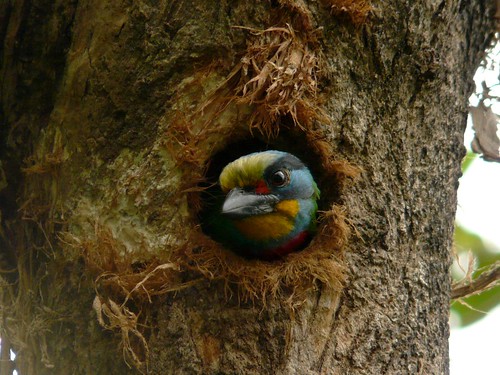I will get to the subject of this (and the many to come) post. But first, here're some two bird species that are easily observed in the garden.
 Black-crowned Night Heron (Nycticorax nycticorax). Even though this animal is found worldwide, even back in Vancouver, this bird was quite active in the morning, scratching its head, preening the feathers, and moving around. Much more active (and closer) than the secretive ones in Canada.
Black-crowned Night Heron (Nycticorax nycticorax). Even though this animal is found worldwide, even back in Vancouver, this bird was quite active in the morning, scratching its head, preening the feathers, and moving around. Much more active (and closer) than the secretive ones in Canada. Common Moorhen (Gallinula chloropus). Another worldwide species and found all over Taiwan.
Common Moorhen (Gallinula chloropus). Another worldwide species and found all over Taiwan.Now, onto the star of today's post - Muller's Barbet! M. nuchalis is the only species in the family Capitonidae in Taiwan, and it is an endemic species here. They are found in low- to mid-elevations, and they are primary cavity-nesting birds, i.e. they excavate their own nest cavities. Only one study done in 1990 focused on this particular species, therefore, the information and results obtained from this research is very valuable. The objective of this study is to record behaviours during the mating season, as well as the relationship between nests and host trees. Besides the adminstrative stuff to get over with when I arrived, I also spent a good chunk of today's time practicing and observing one particular pair of barbets incubating their eggs.
Most of the times, we looked up to where the nest hole is and see if there are any movements. The gender difference between the father and mother is quite difficult to tell since they are not sexual dimorphic. The only known difference (known when copulation positions are recorded and studied carefully) is that the male has a shiny black beak, while the lower-half of the female's beak is duller and grayer.
Most of the times, we just stared up at the circular empty hole. Things get excited when the parent bird poked its head out of the hole and wondered when its substitute is going to arrive. I only got shots of them poking their head out of the hole. Hopefully, I will get some shots of the birds leaving and entering the nest, as well as the parent bird feeding the fledglings when they hatch.
Most of the times, we looked up to where the nest hole is and see if there are any movements. The gender difference between the father and mother is quite difficult to tell since they are not sexual dimorphic. The only known difference (known when copulation positions are recorded and studied carefully) is that the male has a shiny black beak, while the lower-half of the female's beak is duller and grayer.
Most of the times, we just stared up at the circular empty hole. Things get excited when the parent bird poked its head out of the hole and wondered when its substitute is going to arrive. I only got shots of them poking their head out of the hole. Hopefully, I will get some shots of the birds leaving and entering the nest, as well as the parent bird feeding the fledglings when they hatch.

Female, I think. In Chinese, they are translated literally as the "Five-colored Barbet" as they are very colorful.
After work, a co-worker wanted to collect some nests of the Japanese White-eye (since he believe the nests are long gone and abandoned. In the first nest, we saw one dead fledgling. We did not cause its death as it was already dry and dead for a while, which was strange since my friend saw the parent bird feeding it during a few days ago.
What a day! Hope tomorrow will be even better!
.



No comments:
Post a Comment